Remote Sensing Image Classification with a Graph-Based Pre-Trained Neighborhood Spatial Relationship
Abstract
:1. Introduction
- We propose a method to extract the adjacency probability by using a graph.
- The adjacency probability derived from the graph is aggregated with pre-classification results at the decision level.
- Two experiments show that the method has some ability to correct misclassified objects with neighborhood information, but problems regarding global uncertainty and the “siphonic effect” need to be considered in future work.
2. Method
2.1. Generating the Spatial Relationship Graph
2.2. Object-Oriented Fuzzy Classification
2.2.1. Image Segmentation
2.2.2. Selected Fuzzy Classifier
- Nearest neighbor
- Fuzzy SVM
2.3. Aggregation of Graph and Membership
3. Experiments
3.1. Study Area and Satellite Data
3.1.1. Brief Introduction to the Study Area
- Mun River Basin
- 2.
- Kent County, Delaware, USA
3.1.2. Satellite Data and Pre-Processing
- Landsat 8 OLI
- 2.
- Sentinel-2
3.2. Results of the Mun River Basin
3.2.1. Trained Graph in the Mun River Basin
3.2.2. Pre-Fuzzy-Classification Results in the Mun River Basin
3.2.3. Decision Fusion Map of the Mun River Basin
3.2.4. Accuracy Assessment of the Mun River Basin
3.3. Results for Kent County
3.3.1. Trained Graph in Kent County
3.3.2. Pre-Fuzzy-Classification Results in Kent County
3.3.3. Decision Fusion Maps in Kent County
3.3.4. Accuracy Assessment of Kent County
4. Discussion
4.1. Experiments Analysis
4.2. Segmentation Effects
5. Conclusions
Author Contributions
Funding
Data Availability Statement
Acknowledgments
Conflicts of Interest
References
- Li, Y.; Liu, C.; Zhao, W.; Huang, Y. Multi-spectral remote sensing images feature coverage classification based on improved convolutional neural network. Math. Biosci. Eng. 2020, 17, 4443–4456. [Google Scholar] [CrossRef] [PubMed]
- Luo, B.; Zhang, L. Robust Autodual Morphological Profiles for the Classification of High-Resolution Satellite Images. IEEE Trans. Geosci. Remote Sens. 2014, 52, 1451–1462. [Google Scholar] [CrossRef]
- Chen, Z.; Wang, G.; Liu, J. A modified object-oriented classification algorithm and its application in high-resolution remote-sensing imagery. Int. J. Remote Sens. 2012, 33, 3048–3062. [Google Scholar] [CrossRef]
- Scott, G.J.; England, M.R.; Starms, W.A.; Marcum, R.A.; Davis, C.H. Training Deep Convolutional Neural Networks for Land-Cover Classification of High-Resolution Imagery. IEEE Geosci. Remote Sens. Lett. 2017, 14, 549–553. [Google Scholar] [CrossRef]
- Rezaee, M.; Mahdianpari, M.; Zhang, Y.; Salehi, B. Deep Convolutional Neural Network for Complex Wetland Classification Using Optical Remote Sensing Imagery. IEEE J. Sel. Top. Appl. Earth Obs. Remote Sens. 2018, 11, 3030–3039. [Google Scholar] [CrossRef]
- Kussul, N.; Lavreniuk, M.; Skakun, S.; Shelestov, A. Deep Learning Classification of Land Cover and Crop Types Using Remote Sensing Data. IEEE Geosci. Remote Sens. Lett. 2017, 14, 778–782. [Google Scholar] [CrossRef]
- Cheng, G.; Xie, X.X.; Han, J.W.; Guo, L.; Xia, G.S. Remote Sensing Image Scene Classification Meets Deep Learning: Challenges, Methods, Benchmarks, and Opportunities. IEEE J. Sel. Top. Appl. Earth Obs. Remote Sens. 2020, 13, 3735–3756. [Google Scholar] [CrossRef]
- Gu, Y.T.; Wang, Y.T.; Li, Y.S. A Survey on Deep Learning-Driven Remote Sensing Image Scene Understanding: Scene Classification, Scene Retrieval and Scene-Guided Object Detection. Appl. Sci. 2019, 9, 2110. [Google Scholar] [CrossRef] [Green Version]
- Xu, Y.H.; Du, B.; Zhang, L.P. Assessing the Threat of Adversarial Examples on Deep Neural Networks for Remote Sensing Scene Classification: Attacks and Defenses. IEEE Trans. Geosci. Remote Sens. 2021, 59, 1604–1617. [Google Scholar] [CrossRef]
- Zhao, L.J.; Zhang, W.; Tang, P. Analysis of the inter-dataset representation ability of deep features for high spatial resolution remote sensing image scene classification. Multimed. Tools Appl. 2019, 78, 9667–9689. [Google Scholar] [CrossRef]
- Pacifici, F.; Chini, M.; Emery, W.J. A neural network approach using multi-scale textural metrics from very high-resolution panchromatic imagery for urban land-use classification. Remote Sens. Environ. 2009, 113, 1276–1292. [Google Scholar] [CrossRef]
- Zhang, L.P.; Zhang, L.F.; Du, B. Deep Learning for Remote Sensing Data A technical tutorial on the state of the art. IEEE Geosci. Remote Sens. Mag. 2016, 4, 22–40. [Google Scholar] [CrossRef]
- Guo, Q.; Kelly, M.; Gong, P.; Liu, D. An Object-Based Classification Approach in Mapping Tree Mortality Using High Spatial Resolution Imagery. Giscience Remote Sens. 2007, 44, 24–47. [Google Scholar] [CrossRef]
- Goodenough, D.G.; Goldberg, M.; Plunkett, G.; Zelek, J. An expert system for remote sensing. IEEE Trans. Geosci. Remote Sens. 1987, 25, 349–359. [Google Scholar] [CrossRef]
- Metternicht, G. Assessing temporal and spatial changes of salinity using fuzzy logic, remote sensing and gis. Foundations of an expert system. Ecol. Model. 2001, 144, 163–179. [Google Scholar] [CrossRef]
- Kartikeyan, B.; Majumder, K.L.; Dasgupta, A.R. An expert system for land cover classification. IEEE Trans. Geosci. Remote Sens. 1995, 33, 58–66. [Google Scholar] [CrossRef]
- Murai, H.; Omatu, S. Remote sensing image analysis using a neural network and knowledge-based processing. Int. J. Remote Sens. 1997, 18, 811–828. [Google Scholar] [CrossRef]
- Sarma, L.; Sarma, V. A prototype expert system for interpretation of remote sensing image data. Sadhana 1994, 19, 93–111. [Google Scholar] [CrossRef] [Green Version]
- Dobson, M.C.; Pierce, L.E.; Ulaby, F.T. Knowledge-based land-cover classification using ERS-1/JERS-1 SAR composites. IEEE Trans. Geosci. Remote Sens. 1996, 34, 83–99. [Google Scholar] [CrossRef]
- Ghimire, B.; Rogan, J.; Miller, J. Contextual land-cover classification: Incorporating spatial dependence in land-cover classification models using random forests and the getis statistic. Remote Sens. Lett. 2010, 1, 45–54. [Google Scholar] [CrossRef] [Green Version]
- Benz, U.C.; Hofmann, P.; Willhauck, G.; Lingenfelder, I.; Heynen, M. Multi-resolution, object-oriented fuzzy analysis of remote sensing data for GIS-ready information. ISPRS J. Photogramm. Remote Sens. 2004, 58, 239–258. [Google Scholar] [CrossRef]
- Masjedi, A.; Zoej, M.J.V.; Maghsoudi, Y. Classification of polarimetric sar images based on modeling contextual information and using texture features. IEEE Trans. Geosci. Remote Sens. 2016, 54, 932–943. [Google Scholar] [CrossRef]
- Dianat, R.; Kasaei, S. Change Detection in Optical Remote Sensing Images Using Difference-Based Methods and Spatial Information. IEEE Geosci. Remote. Sens. Lett. 2010, 7, 215–219. [Google Scholar] [CrossRef]
- Cui, W.; Wang, F.; He, X.; Zhang, D.Y.; Xu, X.X.; Yao, M.; Wang, Z.W.; Huang, J.J. Multi-Scale Semantic Segmentation and Spatial Relationship Recognition of Remote Sensing Images Based on an Attention Model. Remote Sens. 2019, 11, 1044. [Google Scholar] [CrossRef] [Green Version]
- Qiao, C.; Wang, J.; Shang, J.; Daneshfar, B. Spatial relationship-assisted classification from high-resolution remote sensing imagery. Int. J. Digital Earth 2015, 8, 710–726. [Google Scholar] [CrossRef]
- Bouziani, M.; Goita, K.; He, D.-C. Rule-Based Classification of a Very High Resolution Image in an Urban Environment Using Multispectral Segmentation Guided by Cartographic Data. IEEE Trans. Geosci. Remote Sens. 2010, 48, 3198–3211. [Google Scholar] [CrossRef]
- Benz, U.; Pottier, E. Object based analysis of polarimetric SAR data in alpha-entropy-anisotropy decomposition using fuzzy classification by eCognition. In Proceedings of the IGARSS 2001. Scanning the Present and Resolving the Future. Proceedings. IEEE 2001 International Geoscience and Remote Sensing Symposium, Sydney, Australia, 9–13 July 2001; pp. 1427–1429. [Google Scholar]
- Guarino, N. Formal Ontology in Information Systems. In Proceedings of the 1st International Conference on Formal Ontology in Information Systems, Trento, Italy, 6–8 June 1998; pp. 3–15. [Google Scholar]
- Forestier, G.; Puissant, A.; Wemmert, C.; Gan Ca Rski, P. Knowledge-based region labeling for remote sensing image interpretation. Comput. Environ. Urban Syst. 2012, 36, 470–480. [Google Scholar] [CrossRef] [Green Version]
- Rejichi, S.; Chaabane, F.; Tupin, F. Expert Knowledge-Based Method for Satellite Image Time Series Analysis and Interpretation. IEEE J. Sel. Top. Appl. Earth Obs. Remote Sens. 2015, 8, 2138–2150. [Google Scholar] [CrossRef]
- Mariana, B.; Ivan, T.; Thomas, L.; Thomas, B.; Bernhard, H. Ontology-Based Classification of Building Types Detected from Airborne Laser Scanning Data. Remote Sens. 2014, 6, 1347–1366. [Google Scholar] [CrossRef] [Green Version]
- Forestier, G.; Wemmert, C.; Puissant, A. Coastal image interpretation using background knowledge and semantics. Comput. Geosci. 2013, 54, 88–96. [Google Scholar] [CrossRef] [Green Version]
- Belgiu, M.; Hofer, B.; Hofmann, P. Coupling formalized knowledge bases with object-based image analysis. Remote Sens. Lett. 2014, 5, 530–538. [Google Scholar] [CrossRef]
- Witharana, C.; Bhuiyan, M.A.E.; Liljedahl, A.K.; Kanevskiy, M.; Jorgenson, T.; Jones, B.M.; Daanen, R.; Epstein, H.E.; Griffin, C.G.; Kent, K.; et al. An object-based approach for mapping tundra ice-wedge polygon troughs from very high spatial resolution optical satellite imagery. Remote Sens. 2021, 13, 558. [Google Scholar] [CrossRef]
- Visser, F.; Buis, K.; Verschoren, V.; Schoelynck, J. Mapping of submerged aquatic vegetation in rivers from very high-resolution image data, using object-based image analysis combined with expert knowledge. Hydrobiologia 2018, 812, 157–175. [Google Scholar] [CrossRef] [Green Version]
- Dale, M.R.T.; Fortin, M.J. From Graphs to Spatial Graphs. Annu. Rev. Ecol. Evol. Syst. 2010, 41, 21–38. [Google Scholar] [CrossRef]
- Cheung, A.K.L.; O’Sullivan, D.; Brierley, G. Graph-assisted landscape monitoring. Int. J. Geogr. Inf. Sci. 2015, 29, 580–605. [Google Scholar] [CrossRef]
- Xu, C.; Liu, W. Integrating a Three-Level GIS Framework and a Graph Model to Track, Represent, and Analyze the Dynamic Activities of Tidal Flats. ISPRS Int. J. Geoinf. 2021, 10, 61. [Google Scholar] [CrossRef]
- Ouyang, S.; Li, Y. Combining Deep Semantic Segmentation Network and Graph Convolutional Neural Network for Semantic Segmentation of Remote Sensing Imagery. Remote Sens. 2021, 13, 119. [Google Scholar] [CrossRef]
- Li, Y.; Chen, R.; Zhang, Y.; Zhang, M.; Chen, L. Multi-Label Remote Sensing Image Scene Classification by Combining a Convolutional Neural Network and a Graph Neural Network. Remote Sens. 2020, 12, 4003. [Google Scholar] [CrossRef]
- Ma, L.; Ma, A.D.; Ju, C.; Li, X.M. Graph-based semi-supervised learning for spectral-spatial hyperspectral image classification. Pattern Recognit. Lett. 2016, 83, 133–142. [Google Scholar] [CrossRef]
- Pu, S.; Wu, Y.; Sun, X.; Sun, X. Hyperspectral Image Classification with Localized Graph Convolutional Filtering. Remote Sens. 2021, 13, 526. [Google Scholar] [CrossRef]
- Jabari, S.; Zhang, Y. Building detection in very high resolution satellite image using HIS model. In Proceedings of the ASPRS 2014 Annual Conference, Louisville, KY, USA, 23–28 March 2014. [Google Scholar]
- Sebari, I.; He, D.-C. Automatic fuzzy object-based analysis of VHSR images for urban objects extraction. ISPRS J. Photogramm. Remote Sens. 2013, 79, 171–184. [Google Scholar] [CrossRef]
- Jabari, S.; Zhang, Y. Very high resolution satellite image classification using fuzzy rule-based systems. Algorithms 2013, 6, 762–781. [Google Scholar] [CrossRef]
- Pu, S.; Vosselman, G. Knowledge based reconstruction of building models from terrestrial laser scanning data. ISPRS J. Photogramm. Remote Sens. 2009, 64, 575–584. [Google Scholar] [CrossRef]
- Zhao, M.; Wu, Y.; Pan, S.; Zhou, F.; An, B.; Kaup, A. Automatic registration of images with inconsistent content through line-support region segmentation and geometrical outlier removal. IEEE Trans. Img. Proc. 2018, 27, 2731–2746. [Google Scholar] [CrossRef] [PubMed]
- Chin-Liang, C. Finding Prototypes for Nearest Neighbor Classifiers. IEEE Trans. Comput. 1974, 23, 1179–1184. [Google Scholar] [CrossRef]
- Weinberger, K.Q.; Saul, L.K. Distance Metric Learning for Large Margin Nearest Neighbor Classification. J. Mach. Learn. Res. 2009, 10, 207–244. [Google Scholar] [CrossRef]
- Batuwita, R.; Palade, V. FSVM-CIL: Fuzzy Support Vector Machines for Class Imbalance Learning. IEEE Trans. Fuzzy Syst. 2010, 18, 558–571. [Google Scholar] [CrossRef]
- Fan, R.-E.; Chen, P.-H.; Lin, C.-J. Working set selection using second order information for training SVM. J. Mach. Learn. Res. 2005, 6, 1889–1918. [Google Scholar]
- Hong, D.H.; Hwang, C.H. Support vector fuzzy regression machines. Fuzzy Sets Syst. 2003, 138, 271–281. [Google Scholar] [CrossRef] [Green Version]
- Chesapeake Bay. Available online: http://en.volupedia.org/wiki/Chesapeake_Bay (accessed on 17 March 2021).
- Kent County, Delaware. Available online: https://en.wikipedia.org/wiki/Kent_County,_Delaware (accessed on 17 March 2021).
- Libsvm. Available online: https://www.csie.ntu.edu.tw/~cjlin/libsvm/ (accessed on 7 April 2021).
- Hardin, P.J.; Shumway, J.M. Statistical significance and normalized confusion matrices. Photogramm. Eng. Remote Sens. 1997, 63, 735–740. [Google Scholar]
- Tobler, W. On the First Law of Geography: A Reply. Ann Assoc Am Geogr. 2004, 94, 304–310. [Google Scholar] [CrossRef]
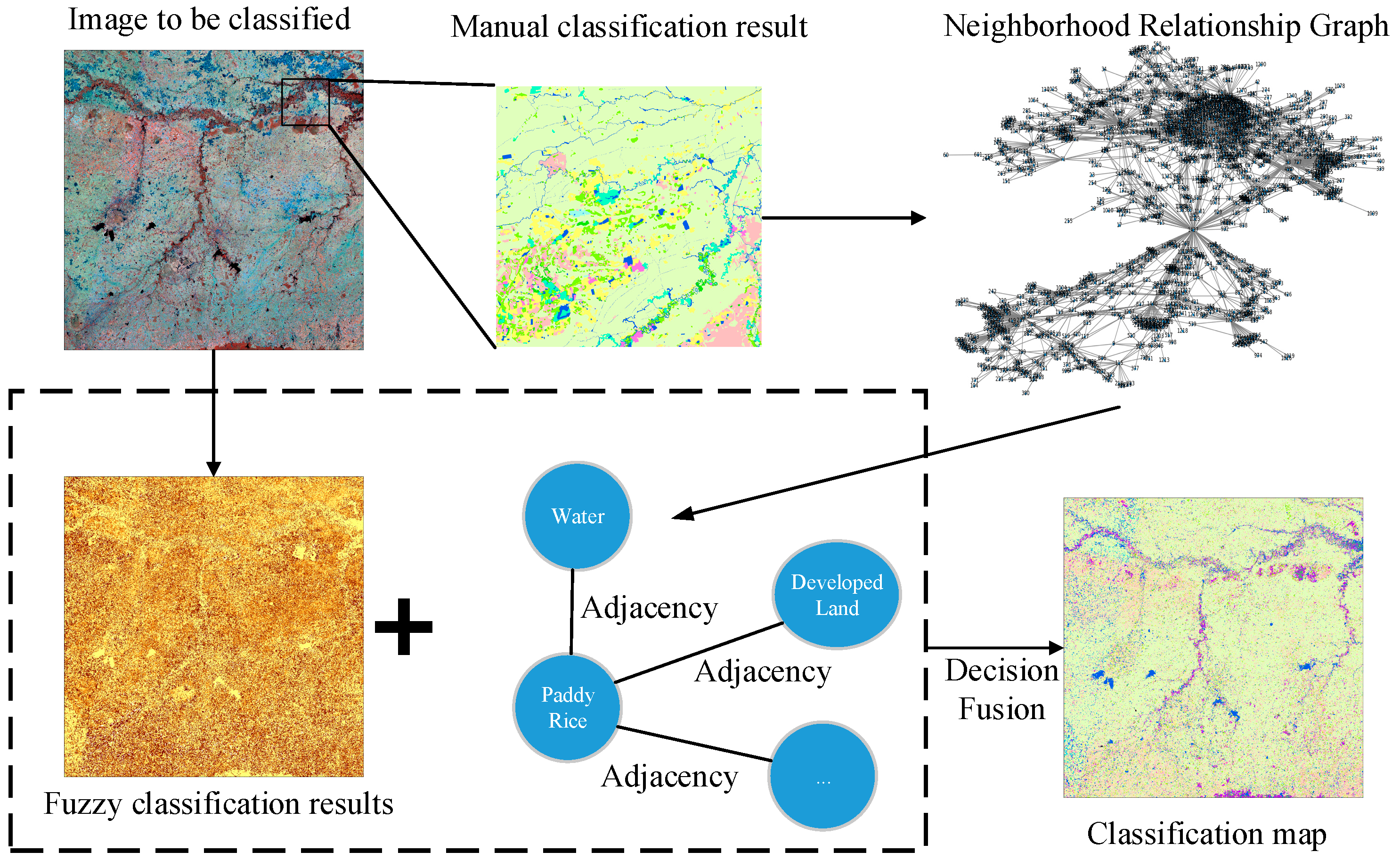
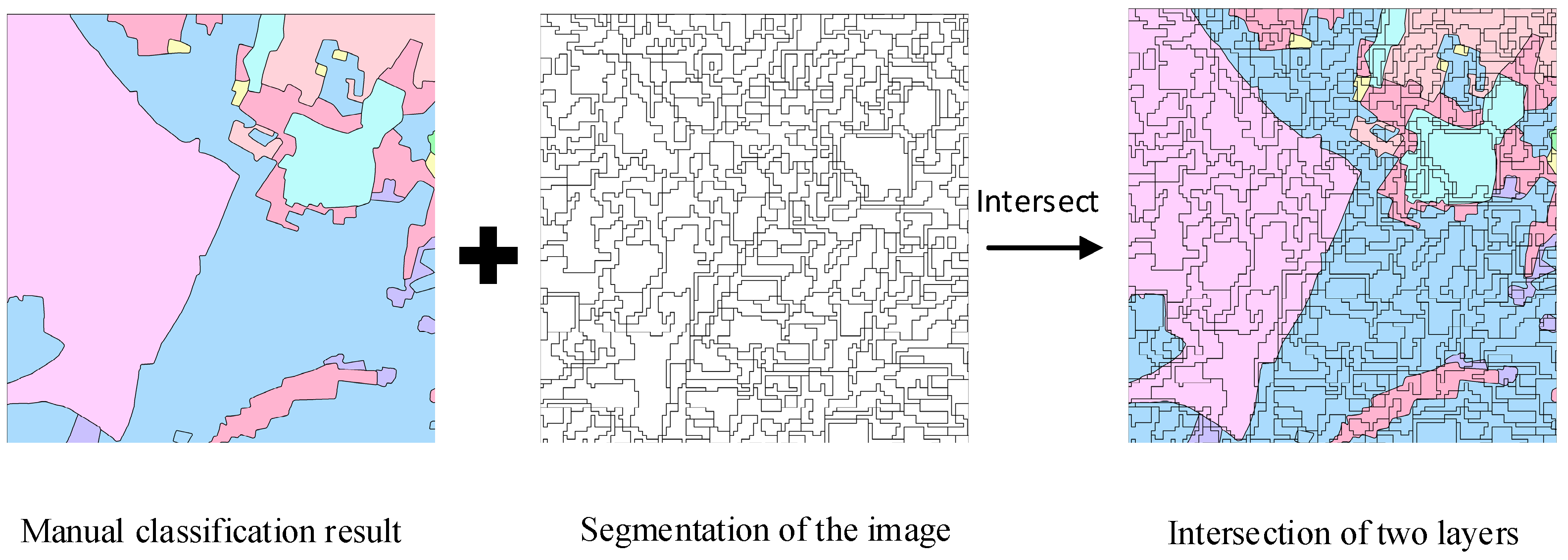
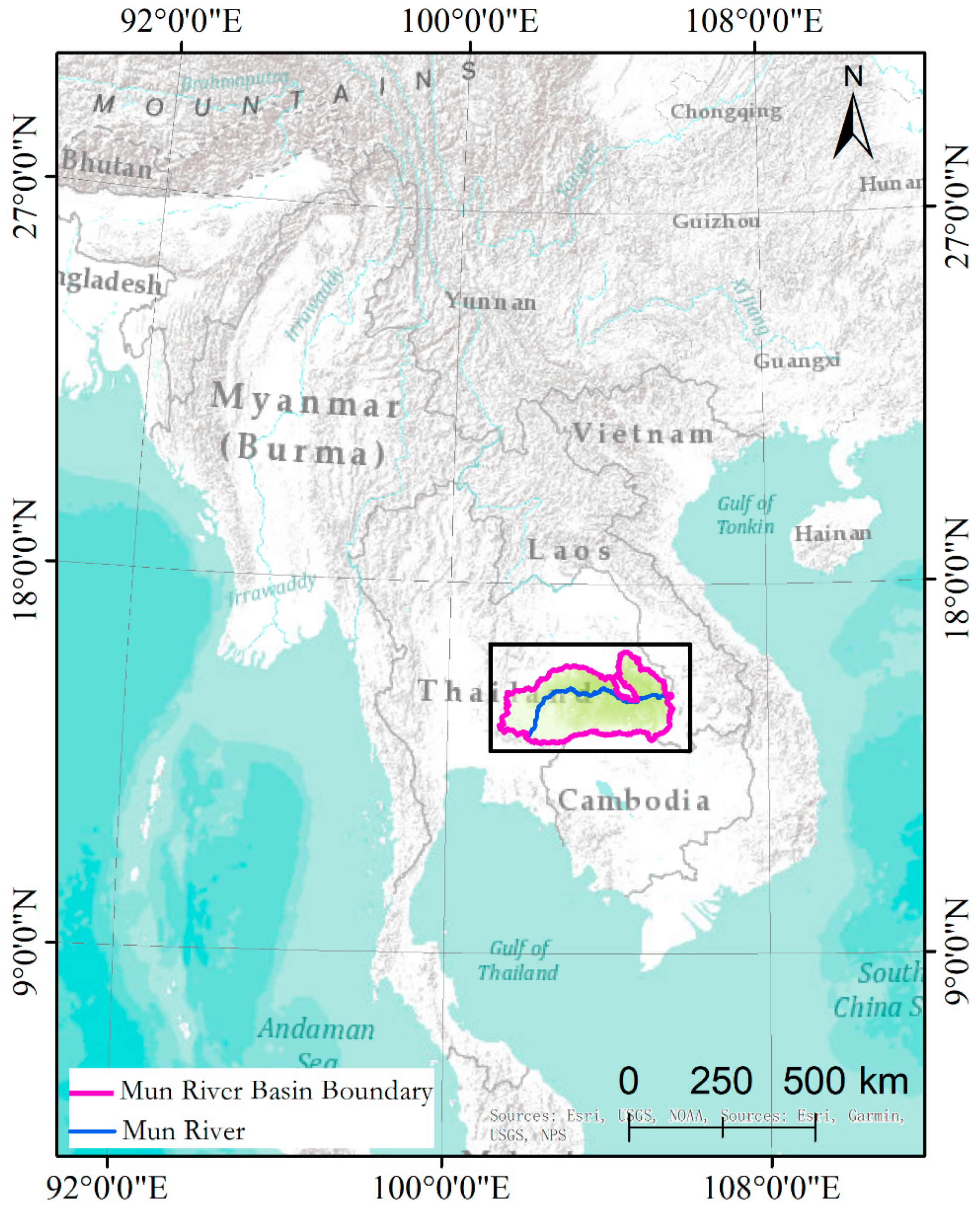


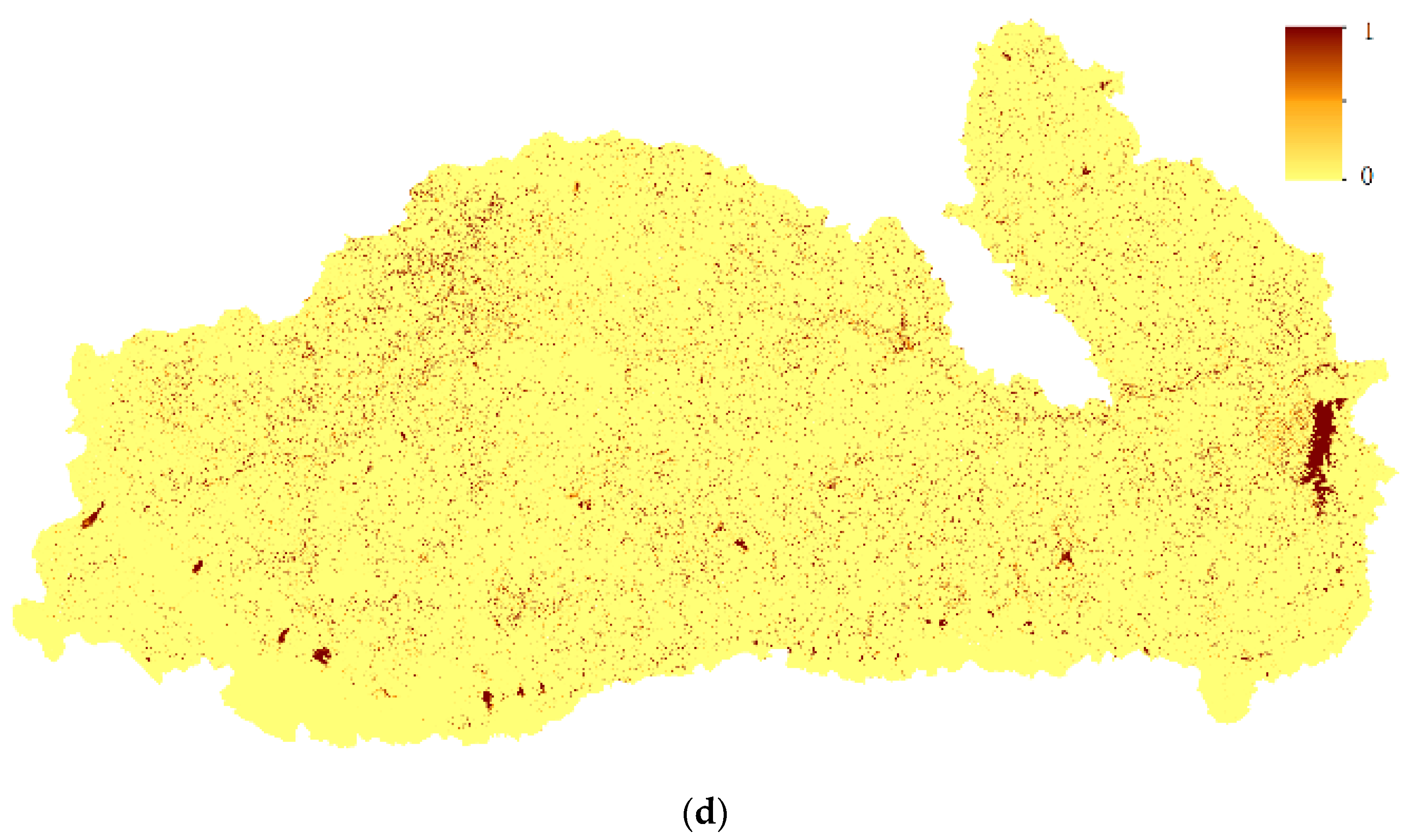
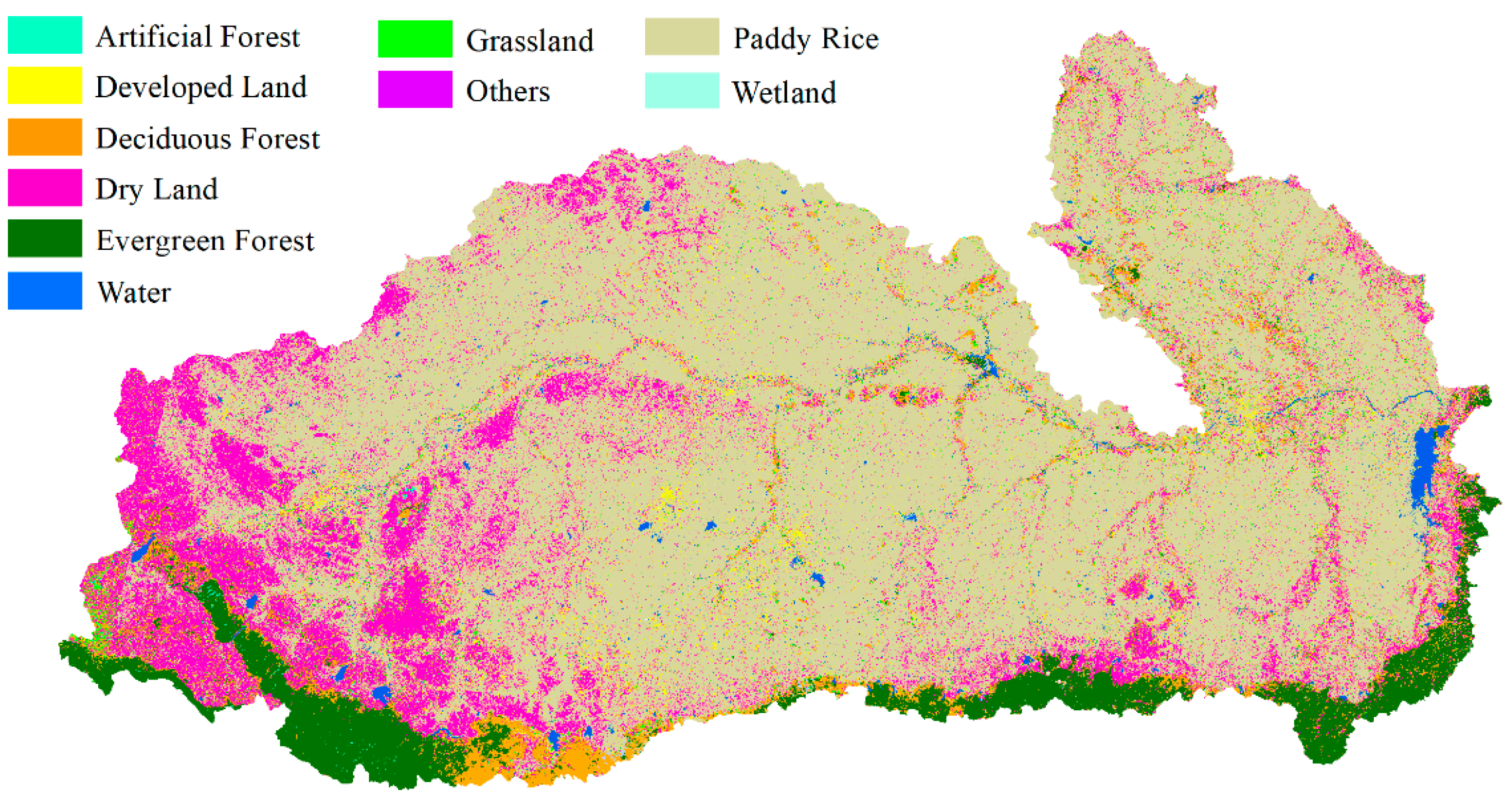
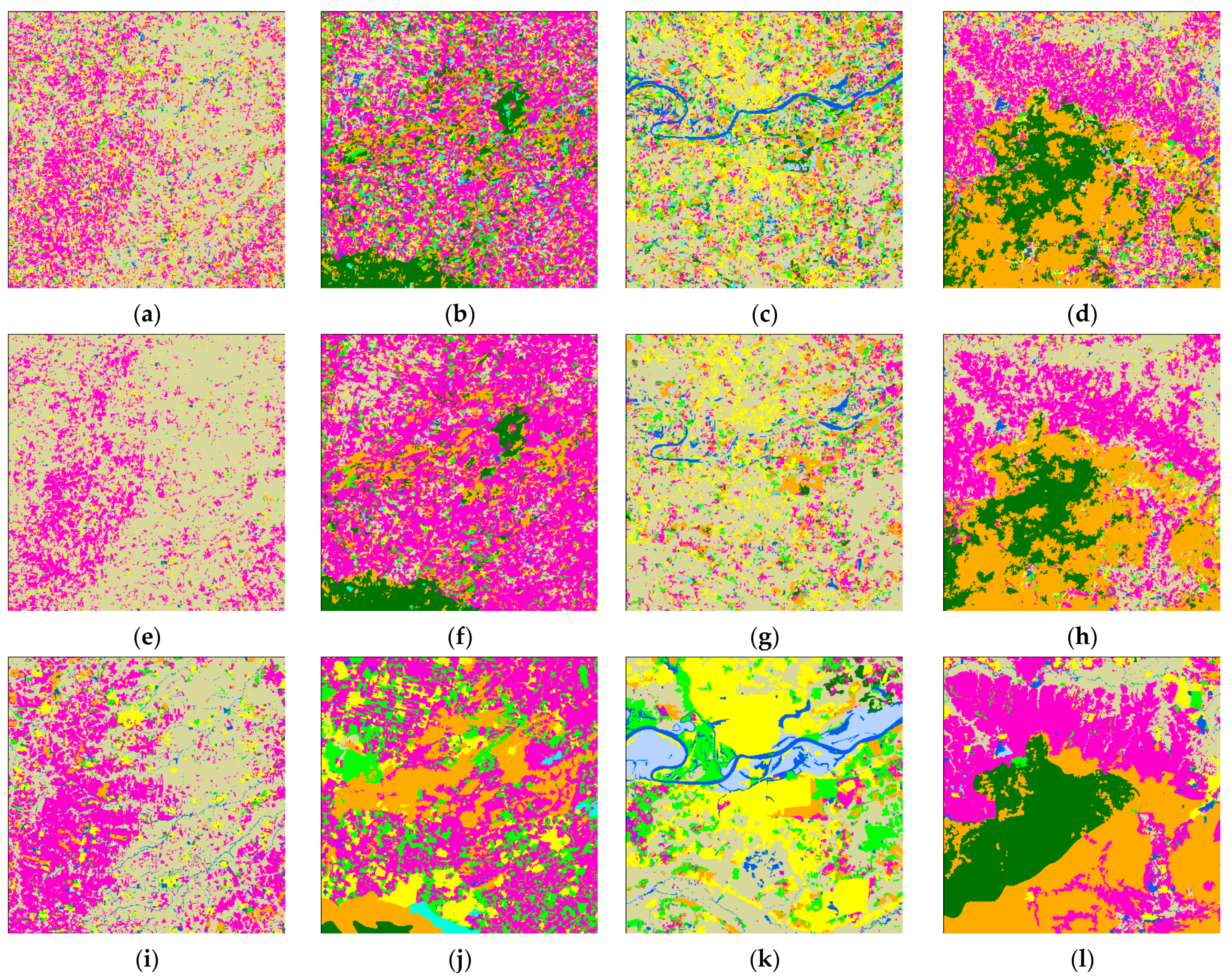
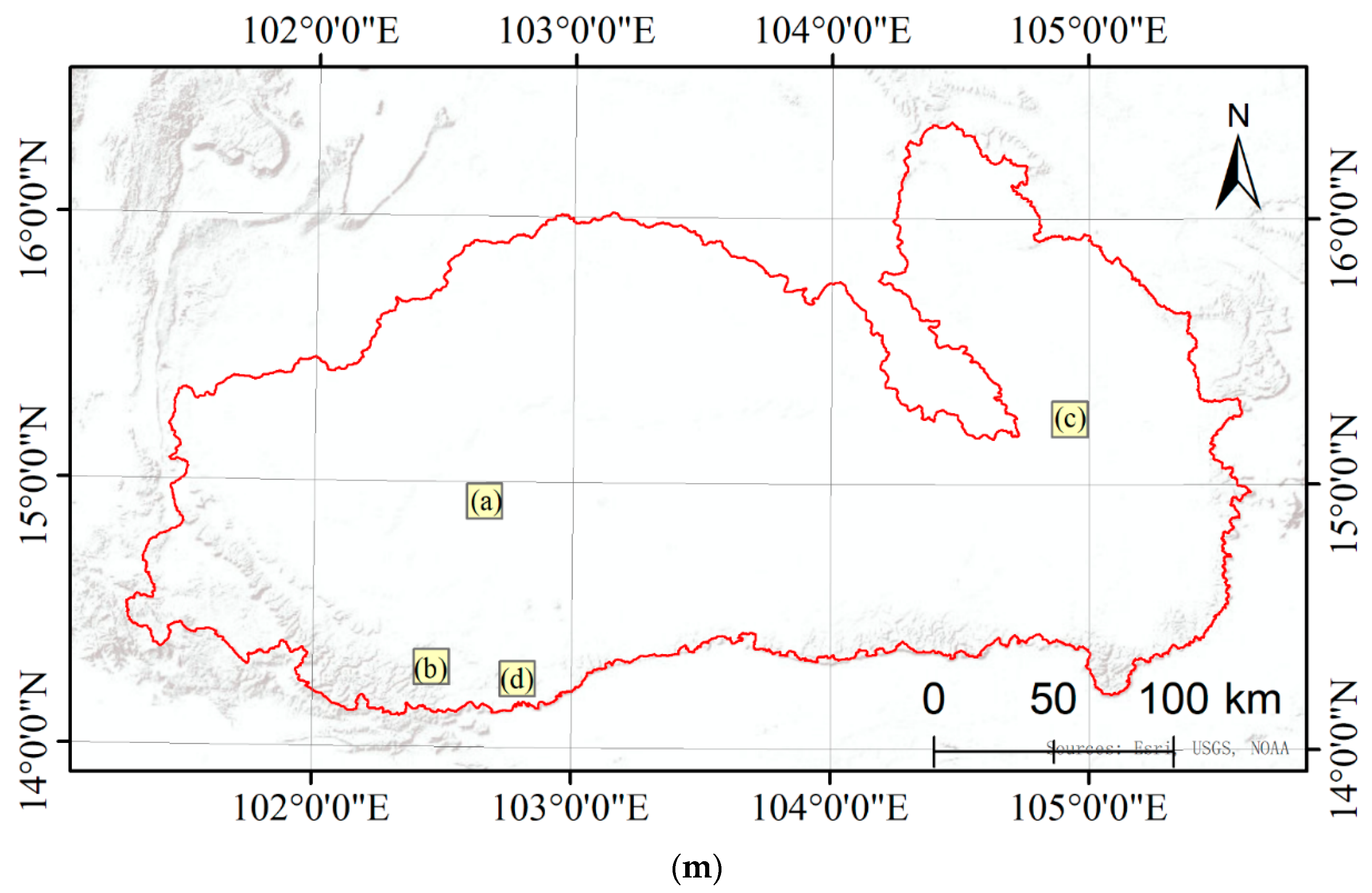

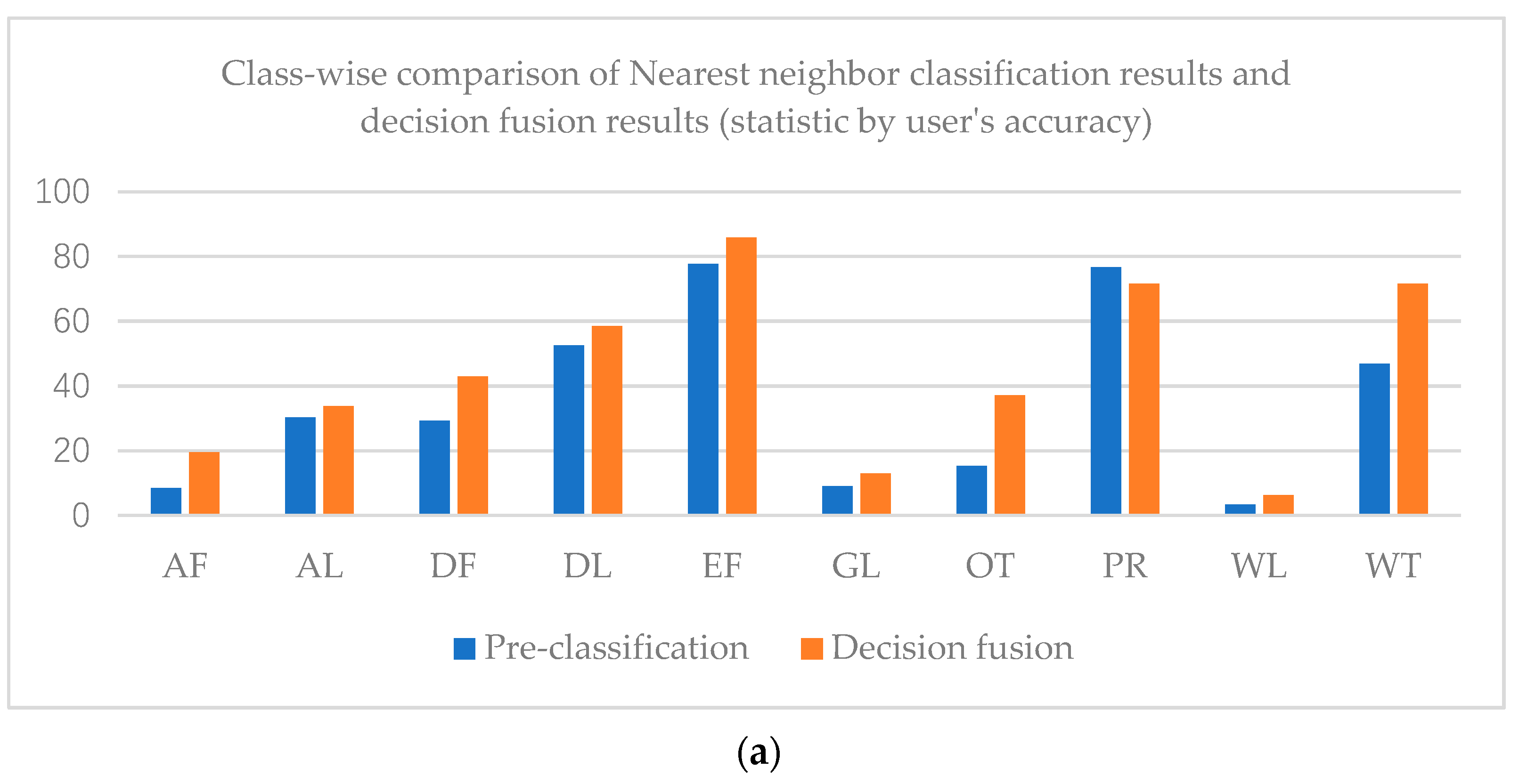
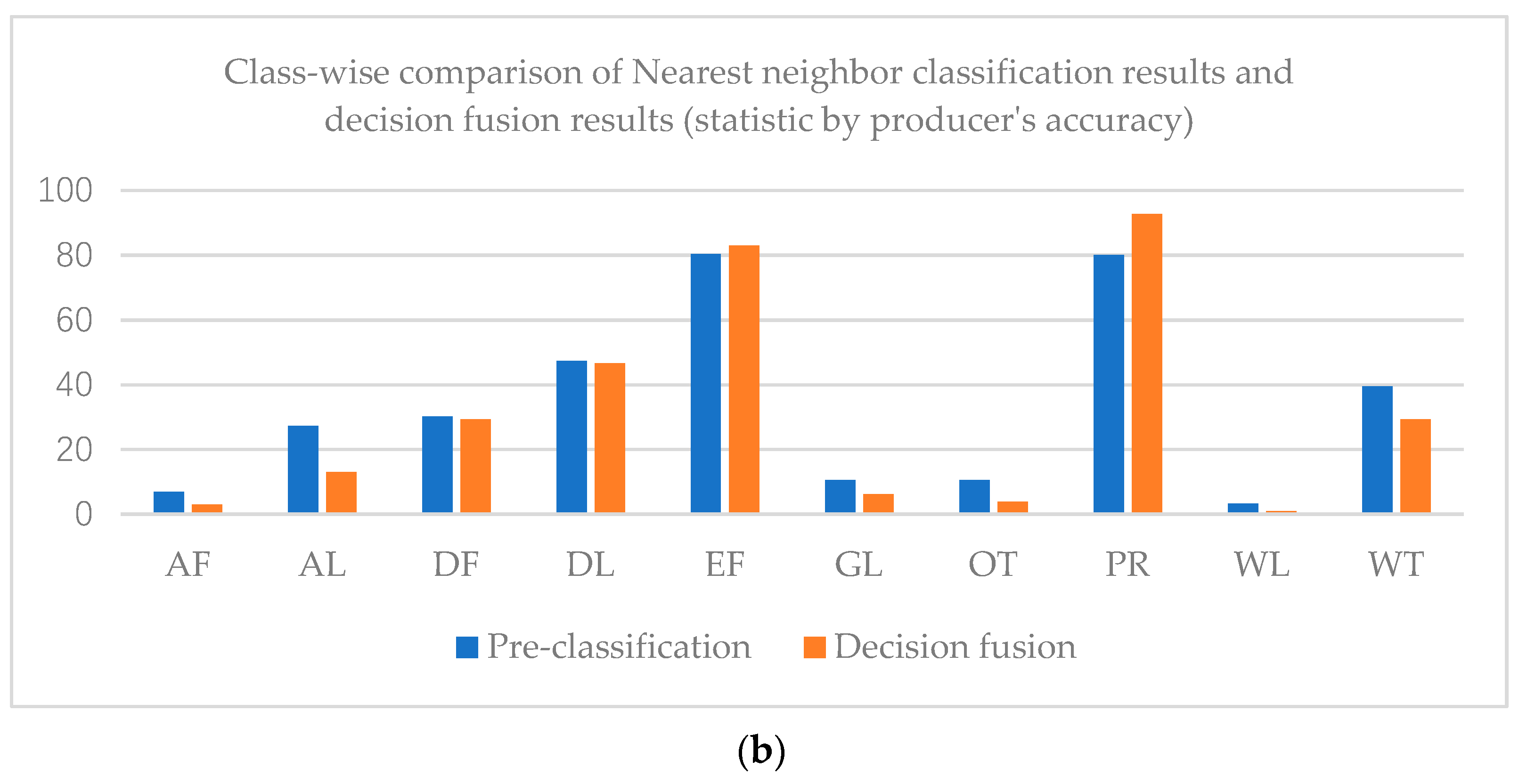

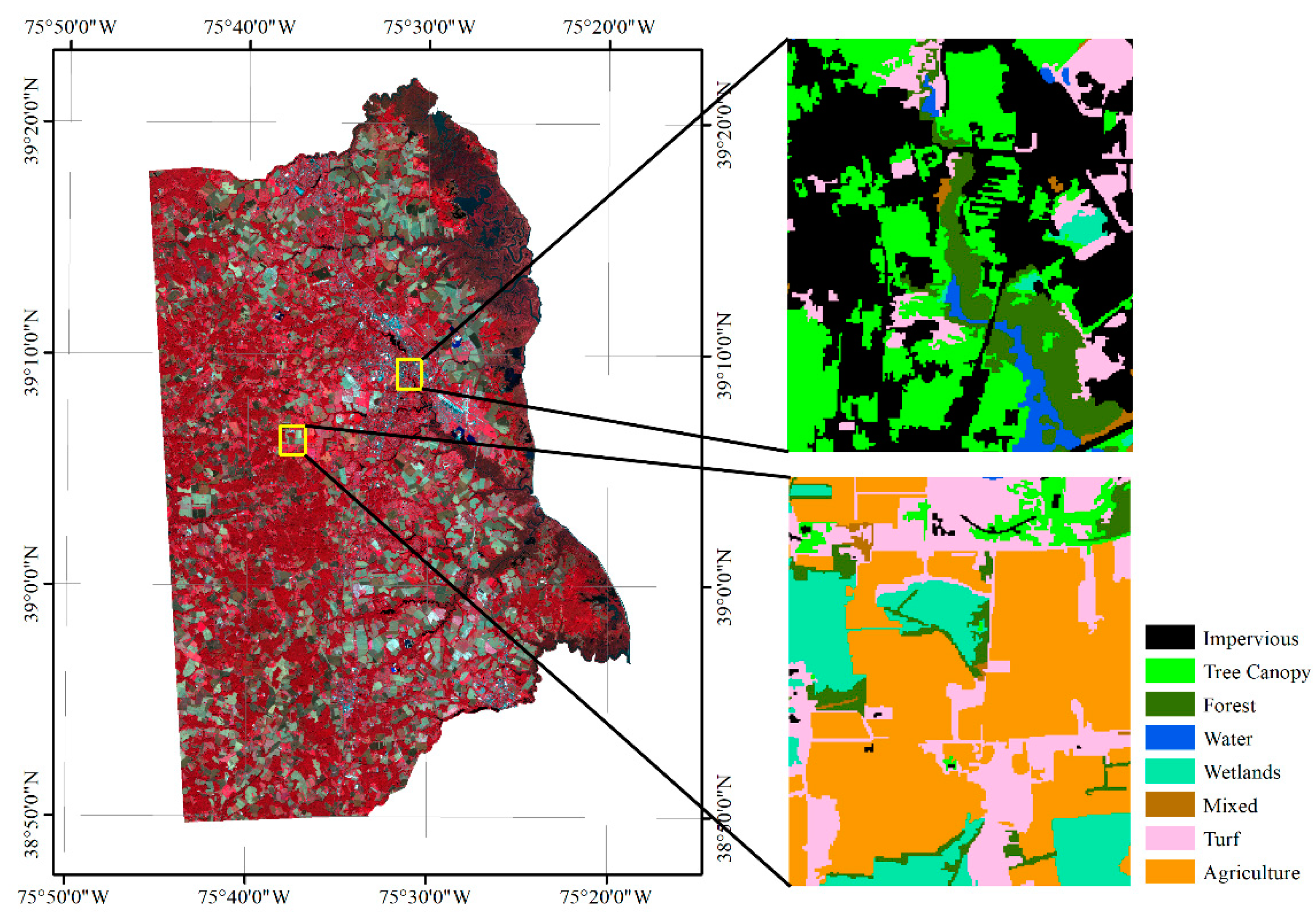


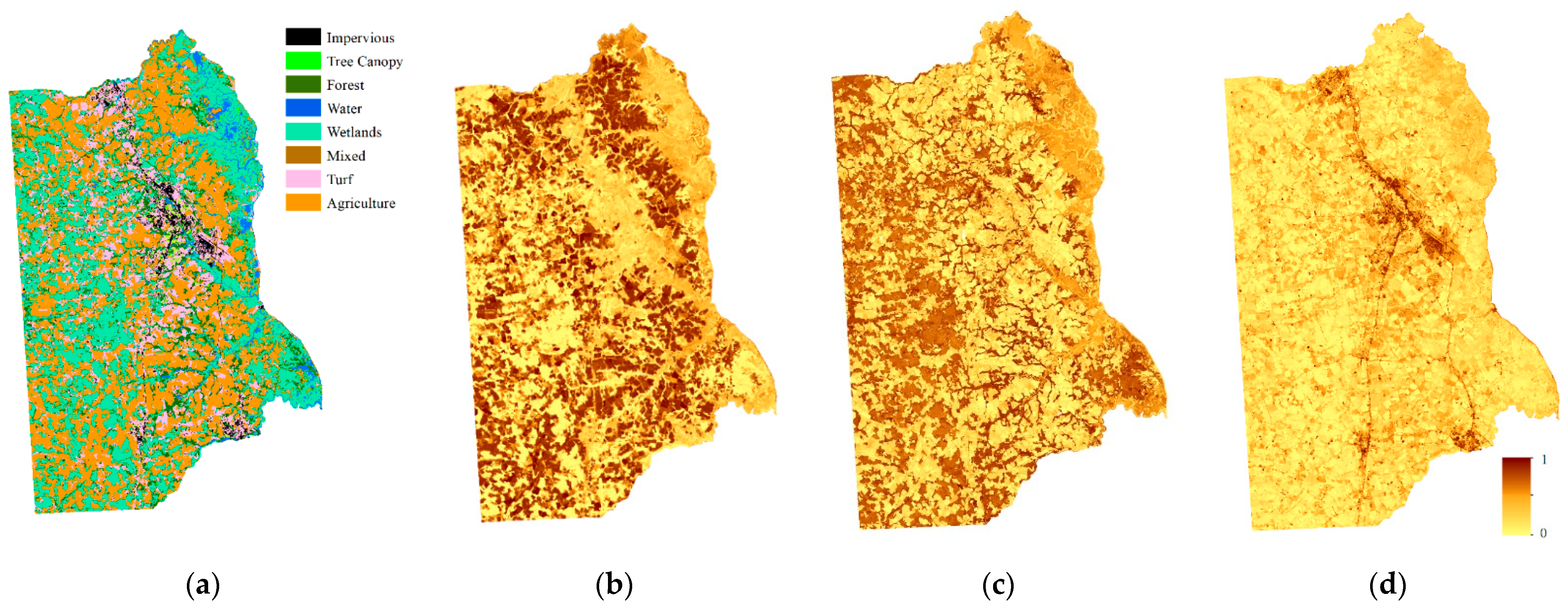
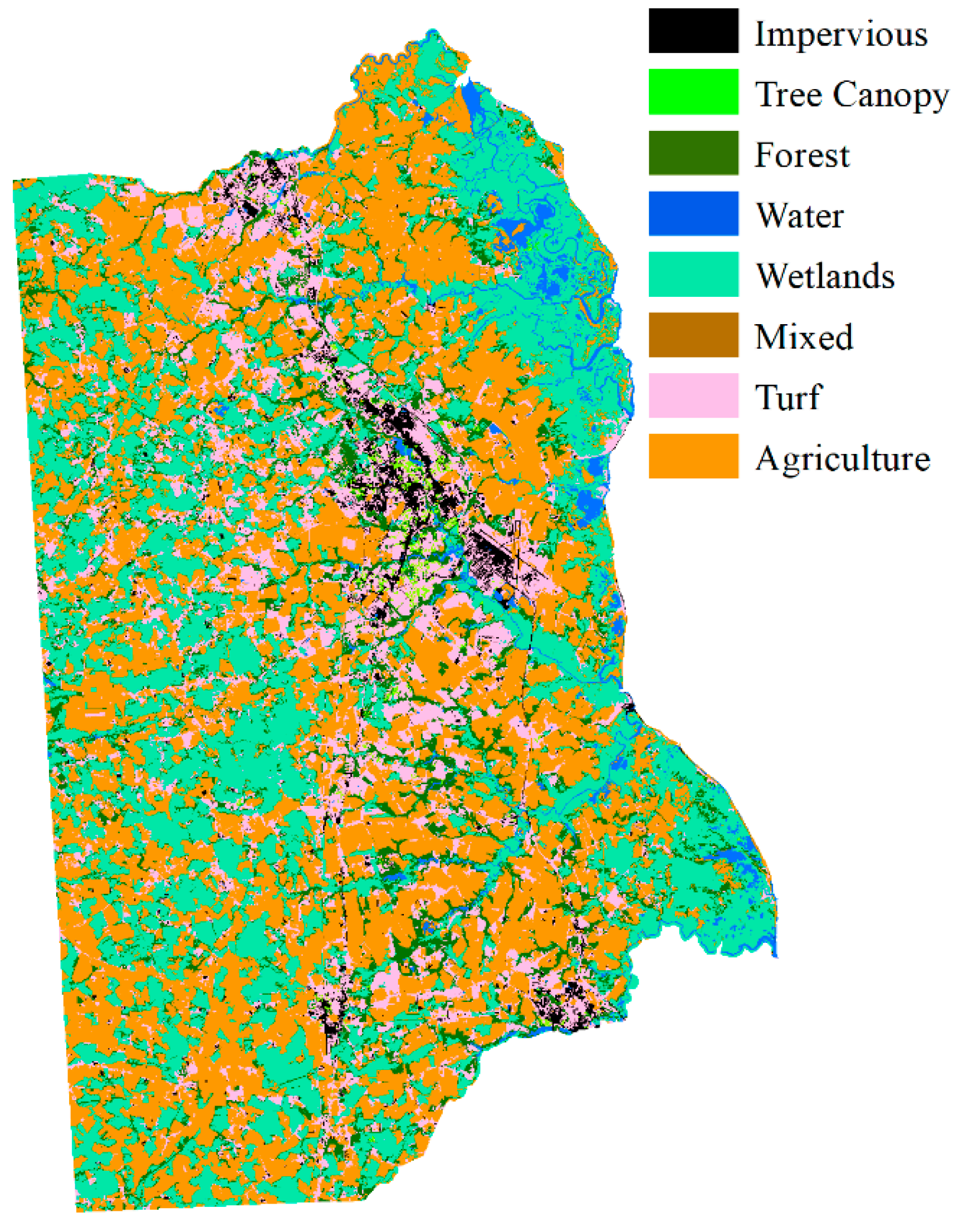
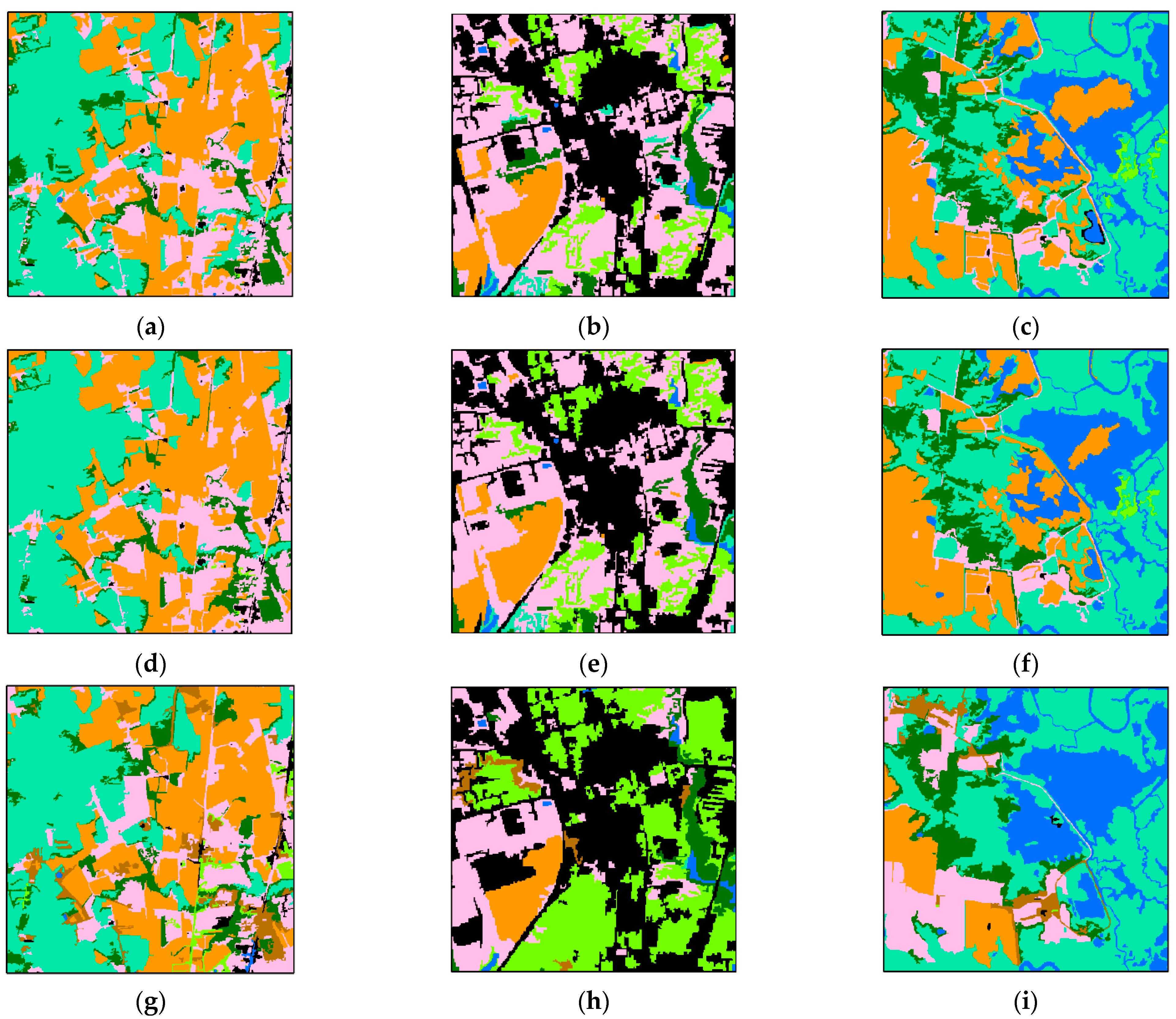
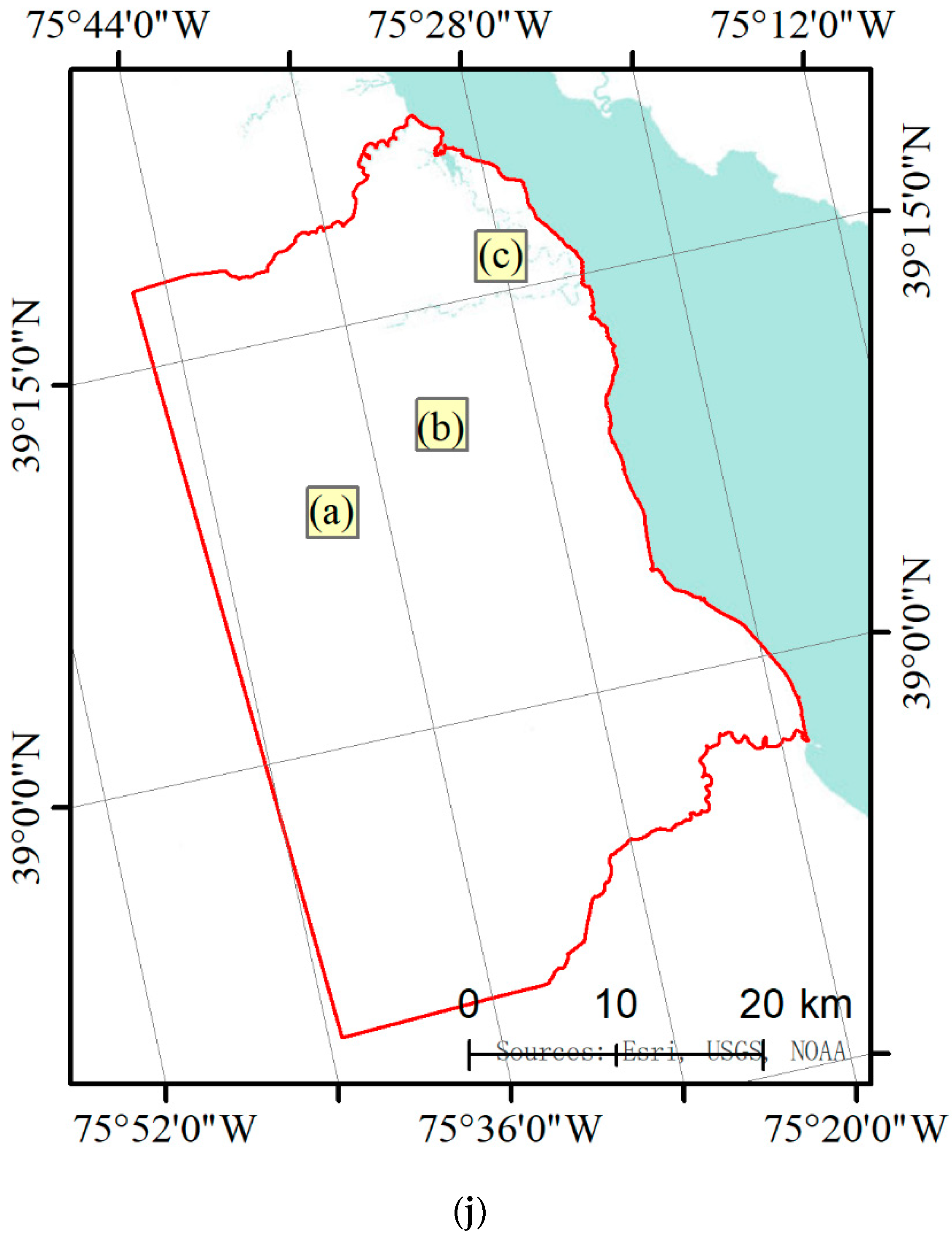
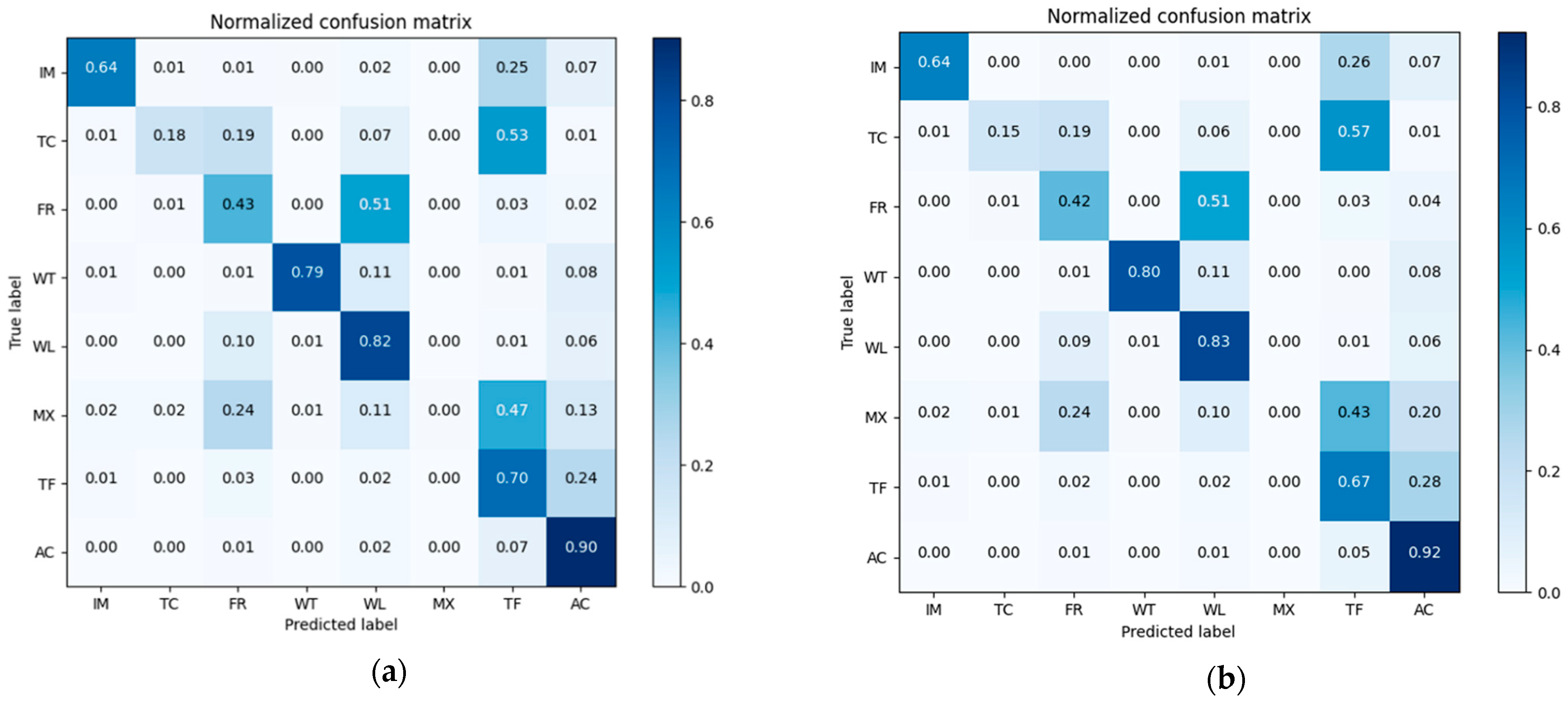
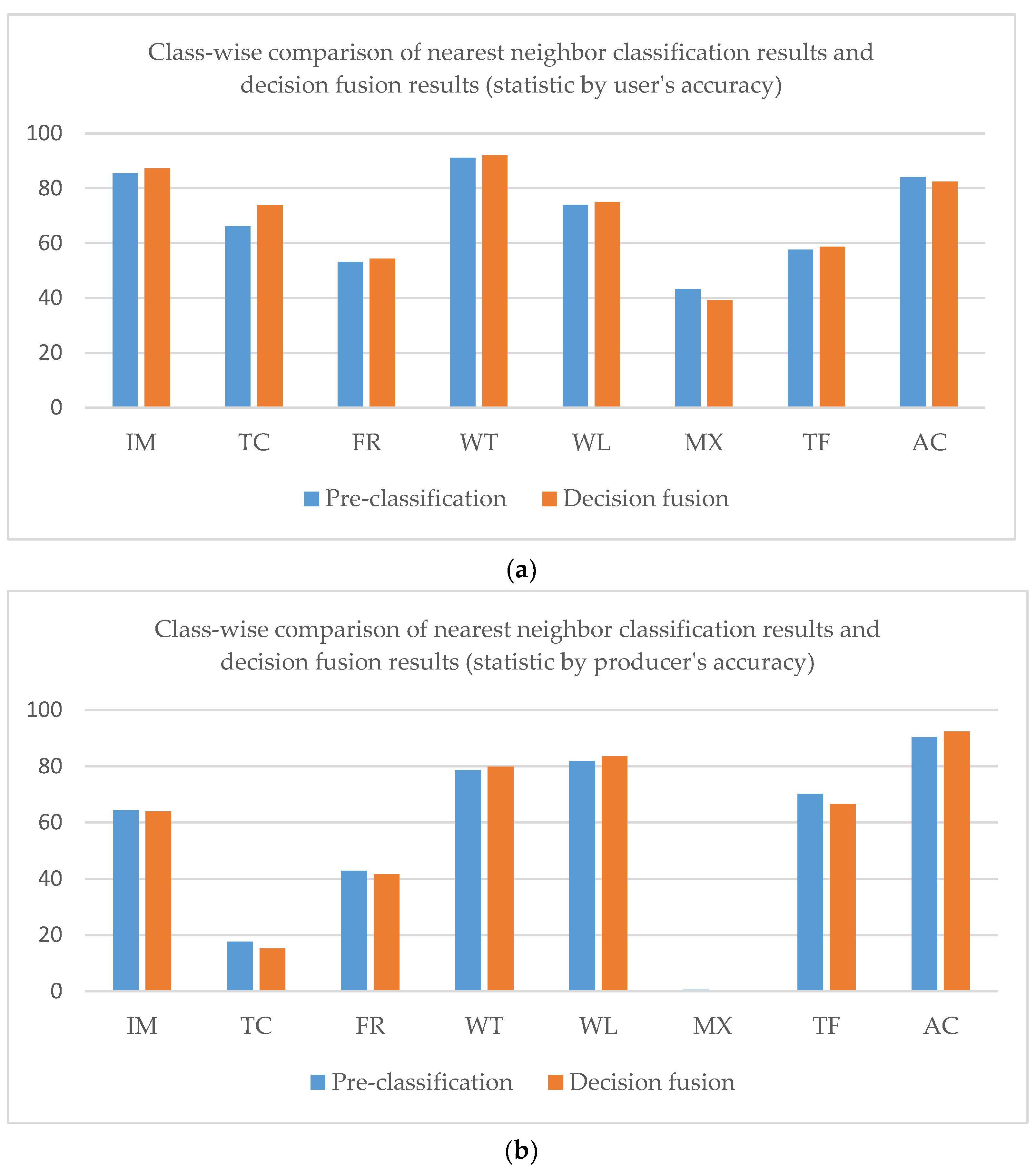

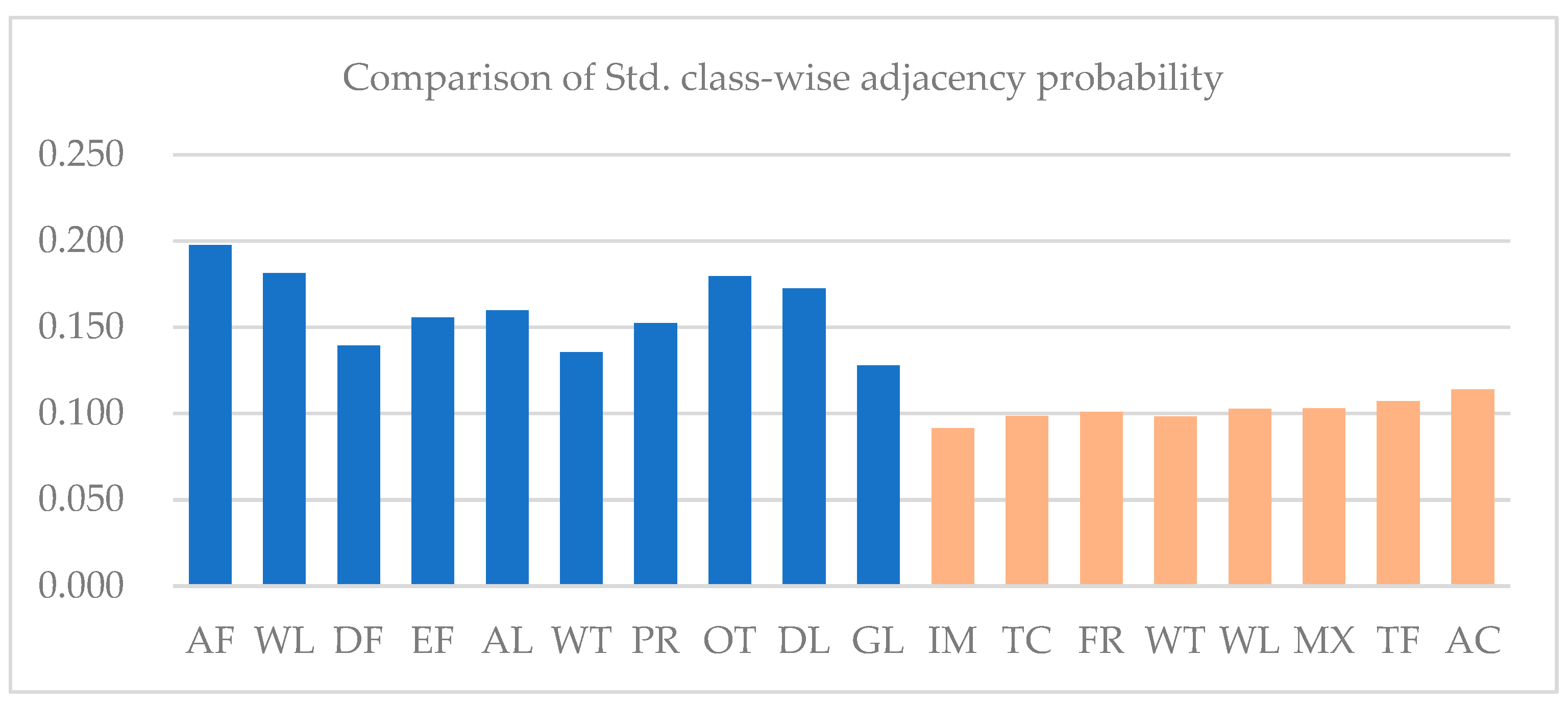
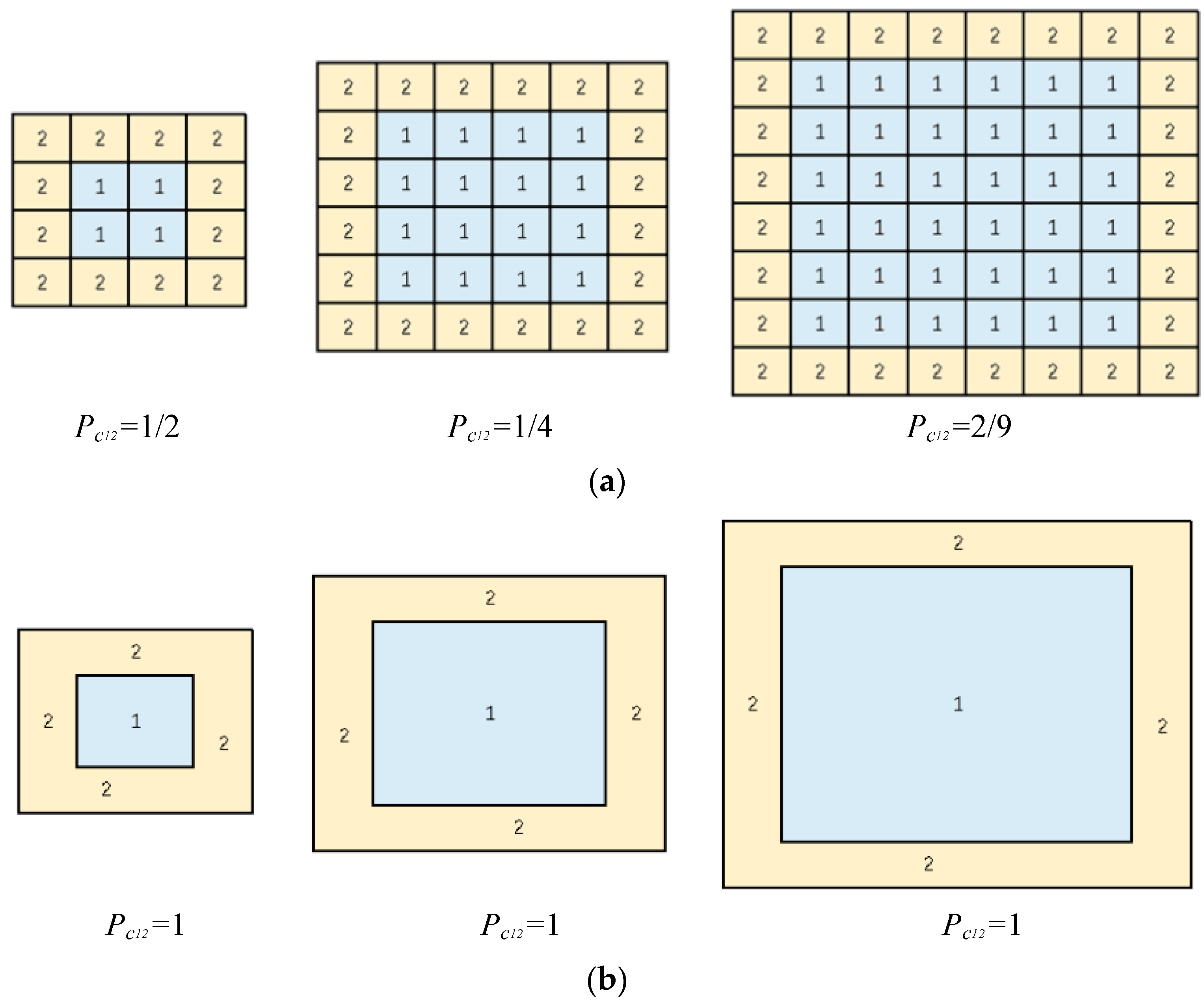
| AF 1 | WL 2 | DF 3 | EF 4 | AL 5 | WT 6 | PR 7 | OT 8 | DL 9 | GL 10 | |
|---|---|---|---|---|---|---|---|---|---|---|
| AF | 0.659 | 0.001 | 0.000 | 0.000 | 0.000 | 0.001 | 0.000 | 0.000 | 0.003 | 0.000 |
| WL | 0.009 | 0.613 | 0.004 | 0.004 | 0.004 | 0.038 | 0.007 | 0.013 | 0.003 | 0.004 |
| DF | 0.007 | 0.017 | 0.489 | 0.001 | 0.020 | 0.028 | 0.046 | 0.029 | 0.042 | 0.060 |
| EF | 0.000 | 0.004 | 0.000 | 0.524 | 0.008 | 0.003 | 0.010 | 0.006 | 0.011 | 0.010 |
| AL | 0.000 | 0.021 | 0.027 | 0.046 | 0.566 | 0.054 | 0.077 | 0.045 | 0.037 | 0.032 |
| WT | 0.025 | 0.130 | 0.025 | 0.012 | 0.032 | 0.478 | 0.055 | 0.022 | 0.014 | 0.043 |
| PR | 0.037 | 0.162 | 0.263 | 0.225 | 0.279 | 0.304 | 0.661 | 0.196 | 0.196 | 0.258 |
| OT | 0.000 | 0.003 | 0.002 | 0.001 | 0.002 | 0.001 | 0.002 | 0.600 | 0.001 | 0.001 |
| DL | 0.258 | 0.026 | 0.124 | 0.136 | 0.062 | 0.036 | 0.087 | 0.057 | 0.635 | 0.128 |
| GL | 0.006 | 0.022 | 0.065 | 0.051 | 0.028 | 0.057 | 0.055 | 0.032 | 0.058 | 0.463 |
| IM 1 | TC 2 | FR 3 | WT 4 | WL 5 | MX 6 | TF 7 | AC 8 | |
|---|---|---|---|---|---|---|---|---|
| IM | 0.101 | 0.027 | 0.144 | 0.018 | 0.183 | 0.048 | 0.170 | 0.308 |
| TC | 0.057 | 0.045 | 0.173 | 0.024 | 0.155 | 0.041 | 0.169 | 0.335 |
| FR | 0.051 | 0.028 | 0.175 | 0.033 | 0.182 | 0.039 | 0.159 | 0.334 |
| WT | 0.036 | 0.022 | 0.193 | 0.028 | 0.215 | 0.046 | 0.165 | 0.295 |
| WL | 0.050 | 0.022 | 0.150 | 0.030 | 0.216 | 0.049 | 0.149 | 0.334 |
| MX | 0.058 | 0.022 | 0.127 | 0.026 | 0.206 | 0.058 | 0.160 | 0.343 |
| TF | 0.055 | 0.028 | 0.145 | 0.027 | 0.170 | 0.047 | 0.162 | 0.366 |
| AC | 0.046 | 0.024 | 0.142 | 0.022 | 0.176 | 0.045 | 0.163 | 0.382 |
| Situation 1: | |||||
| Object Membership | Adjacent Membership | Adjacency Probability | True Class | Pre-Classified Result | Decision Result |
| Class A: 0.35 | Class A: 0.37 | A-A: 0.1 B-B: 0.3 A-B:0.05 | Class A | Class A | Class B |
| Class B: 0.32 | Class B: 0.23 | ||||
| Situation 2: | |||||
| Object Membership | Adjacent Membership | Adjacency Probability | True Class | Pre-Classified Result | Decision Result |
| Class A: 0.35 | Class A: 0.27 | A-A: 0.1 B-B: 0.3 A-B:0.05 | Class A | Class A | Class B |
| Class B: 0.22 | Class B: 0.73 | ||||
Publisher’s Note: MDPI stays neutral with regard to jurisdictional claims in published maps and institutional affiliations. |
© 2021 by the authors. Licensee MDPI, Basel, Switzerland. This article is an open access article distributed under the terms and conditions of the Creative Commons Attribution (CC BY) license (https://creativecommons.org/licenses/by/4.0/).
Share and Cite
Guan, X.; Huang, C.; Yang, J.; Li, A. Remote Sensing Image Classification with a Graph-Based Pre-Trained Neighborhood Spatial Relationship. Sensors 2021, 21, 5602. https://doi.org/10.3390/s21165602
Guan X, Huang C, Yang J, Li A. Remote Sensing Image Classification with a Graph-Based Pre-Trained Neighborhood Spatial Relationship. Sensors. 2021; 21(16):5602. https://doi.org/10.3390/s21165602
Chicago/Turabian StyleGuan, Xudong, Chong Huang, Juan Yang, and Ainong Li. 2021. "Remote Sensing Image Classification with a Graph-Based Pre-Trained Neighborhood Spatial Relationship" Sensors 21, no. 16: 5602. https://doi.org/10.3390/s21165602
APA StyleGuan, X., Huang, C., Yang, J., & Li, A. (2021). Remote Sensing Image Classification with a Graph-Based Pre-Trained Neighborhood Spatial Relationship. Sensors, 21(16), 5602. https://doi.org/10.3390/s21165602







